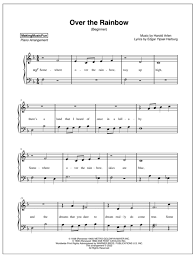Exploring Basic Piano Sheet Music
Learning to play the piano is a rewarding journey that begins with mastering the basics of reading sheet music. Whether you’re a beginner or looking to brush up on your skills, understanding basic piano sheet music is essential for any aspiring pianist.
Key Components of Piano Sheet Music
Piano sheet music consists of two main components: the musical staff and notes. The musical staff is made up of five lines and four spaces, each representing a different pitch. Notes placed on the staff indicate which keys to play on the piano.
Treble Clef vs. Bass Clef
The treble clef is typically used for higher-pitched notes played with the right hand, while the bass clef is used for lower-pitched notes played with the left hand. Understanding how to read both clefs is essential for playing piano pieces that utilize a wide range of notes.
Note Durations and Symbols
In addition to notes indicating pitch, sheet music also includes symbols that represent note durations, such as whole notes, half notes, quarter notes, and more. Learning how to count beats and hold notes for the correct duration is crucial for playing music accurately.
Practice Makes Perfect
Practice is key when it comes to mastering basic piano sheet music. Start with simple exercises and gradually progress to more complex pieces as you build your skills. Consistent practice will help you develop fluency in reading sheet music and playing with precision.
Mastering the Basics: A Guide to Understanding Piano Sheet Music
- What are the basic components of piano sheet music?
- How do I read notes on the musical staff?
- What is the difference between the treble clef and bass clef?
- What do note durations and symbols indicate in piano sheet music?
- How can I improve my skills in reading and playing basic piano sheet music?
What are the basic components of piano sheet music?
Understanding the basic components of piano sheet music is essential for aspiring pianists. The key elements include the musical staff, which consists of five lines and four spaces representing different pitches, and notes placed on the staff indicating which keys to play. Additionally, knowing the difference between the treble clef for higher-pitched notes played with the right hand and the bass clef for lower-pitched notes played with the left hand is crucial. Familiarity with note durations and symbols, such as whole notes and quarter notes, is also important for accurately interpreting sheet music. By mastering these fundamental components, pianists can effectively read and play a wide range of musical pieces with confidence and skill.
How do I read notes on the musical staff?
Understanding how to read notes on the musical staff is a fundamental skill for any aspiring pianist. The musical staff, comprised of five lines and four spaces, serves as a visual guide for indicating different pitches. Each note placed on the staff corresponds to a specific key on the piano, dictating which keys to play. By familiarizing oneself with the treble clef for higher-pitched notes played with the right hand and the bass clef for lower-pitched notes played with the left hand, musicians can navigate sheet music with confidence and precision. Practice and repetition are essential in honing this skill, enabling musicians to interpret and play music fluently on the piano.
What is the difference between the treble clef and bass clef?
The difference between the treble clef and bass clef lies in their respective roles in representing different ranges of notes on the musical staff. The treble clef, also known as the G clef, is used to notate higher-pitched notes typically played with the right hand on the piano. On the other hand, the bass clef, or F clef, is employed for lower-pitched notes that are commonly played with the left hand. Understanding these clefs is essential for pianists as they indicate which keys to play and help distinguish between notes that fall within different octaves. Mastering the distinction between treble and bass clefs is fundamental for reading and interpreting piano sheet music accurately.
What do note durations and symbols indicate in piano sheet music?
Note durations and symbols in piano sheet music play a crucial role in guiding musicians on how long each note should be held or played. These musical notations provide valuable information on the rhythm and timing of a piece, helping pianists maintain a consistent tempo and flow throughout their performance. From whole notes to sixteenth notes, each symbol represents a specific duration that contributes to the overall musical expression and interpretation of a composition. Understanding these note durations is essential for accurately translating the composer’s intentions into captivating melodies on the piano.
How can I improve my skills in reading and playing basic piano sheet music?
To enhance your proficiency in reading and playing basic piano sheet music, consistent practice is key. Start by familiarizing yourself with the musical staff, notes, and clefs. Practice identifying notes on the staff and associating them with the corresponding keys on the piano. Gradually increase the complexity of the pieces you practice, incorporating different note durations and rhythms. Utilize resources such as beginner-level sheet music books, online tutorials, and instructional videos to reinforce your learning. Set aside dedicated time each day for practice sessions to build fluency in reading sheet music and improve your piano playing skills over time. Remember, patience and persistence are essential in mastering the art of playing the piano through sheet music interpretation.

